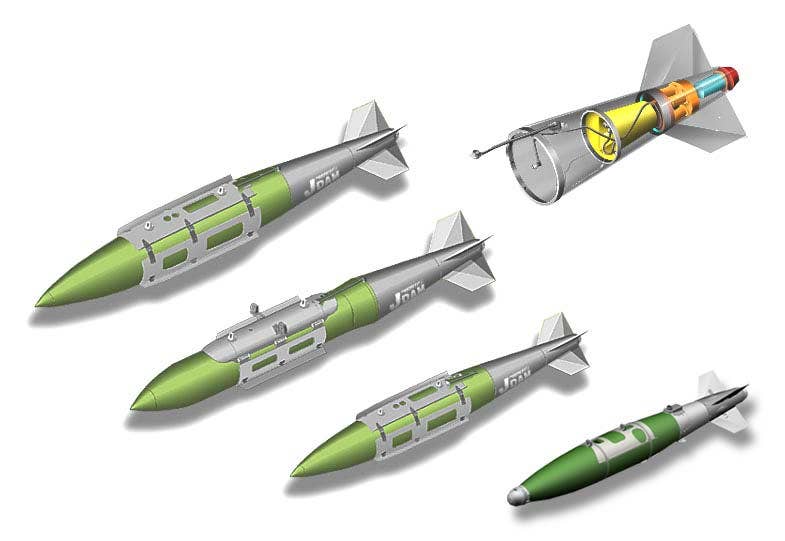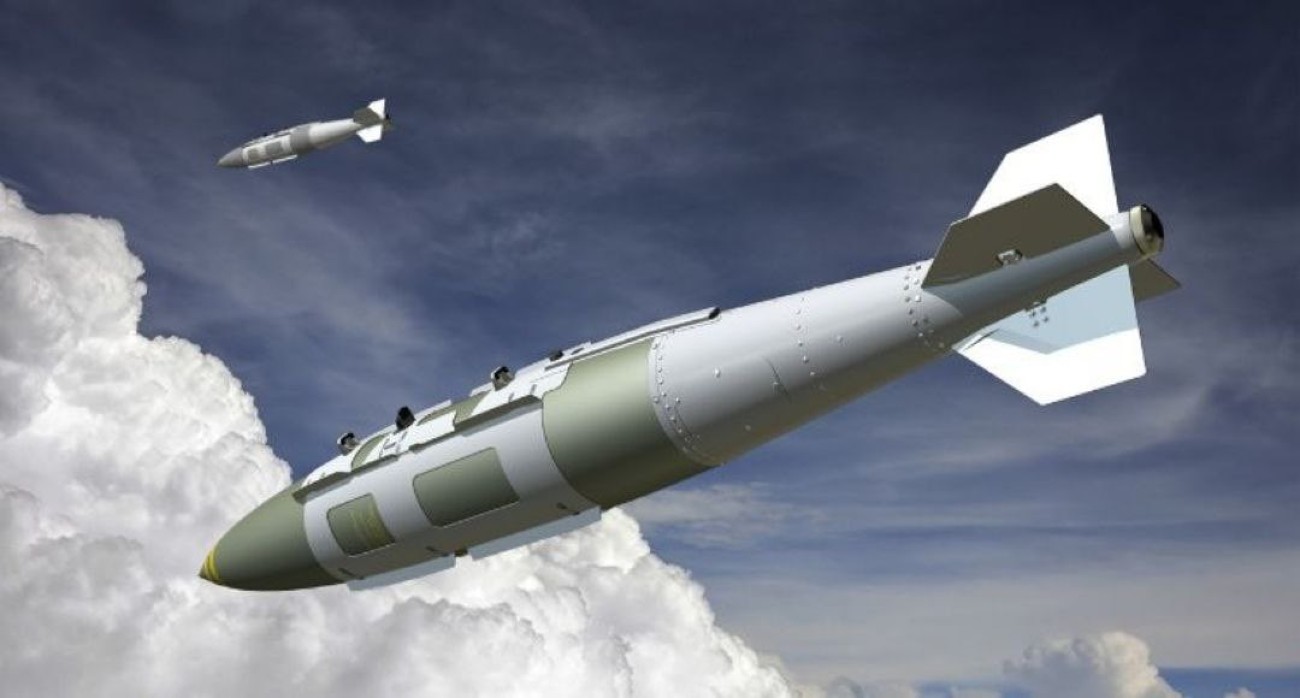The Russian military appears to have begun employing what is believed to be its own version of the US-made Joint Direct Attack Munitions (JDAMs) in the eastern Ukrainian region of Donbas, according to reports from the battlefield.
The pro-Russian Fighterbomber Telegram channel posted a video, a compilation of multiple clips showing the reported use of a FAB-500M-62 bomb, believed to be equipped with an aerial guidance kit called Modul Planirovaniya I Korrektsi (MPK), or “gliding and correction module.”
The Russian Ministry of Defense (RuMoD) has not yet officially commented on the alleged use of these aerial guidance kits. However, Russian media outlets have reported that dumb bombs equipped with these kits have begun to be used in the Avdeevka region.
Also, a Russian media outlet called ‘Military Review’ shared images of an unexploded FAB-500 aerial bomb found on one of the streets of the Kuibyshevsky district of Donetsk.
Interestingly, only 500 meters from this bomb, what seems to be an aerial guidance kit, was also found, according to Military Review.
Russian Aerospace Forces have begun using new high-precision glide bombs.
Unexploded FAB-500 aerial bomb was found in Donetsk with a new control and correction unit. pic.twitter.com/ve36tCBO88
— Clash Report (@clashreport) March 12, 2023
“The wings are also clearly visible in the photographs of the product (debris),” Military Review noted.
In early January, an image surfaced online, also shared by the Fighterbomber channel on Telegram, of what appeared to be a FAB-500M-62 bomb with a mysterious wing kit attached to it, reportedly loaded onto a Russian Su-34 Fullback combat jet.
At the time, netizens compared the munition seen in the image with the US’ Joint Direct Attack Munition (JDAM) family of precision-guided bombs, which the US has provided to the Ukrainian Air Force.
Reports of alleged Russian use of FAB-500M-62 bomb equipped with aerial guidance kit began shortly after the Ukrainian military reportedly began using the US-supplied JDAM bomb on Russian-held positions in the Bakhmut region.
The military-political expert and advisor to the acting DPR leader, Yan Gagin, told the Russian state-owned TASS news agency on March 10 that the Ukrainian military dropped a JDAM bomb on the area of Kurdyumovka near the Bakhmut region of the Donetsk People’s Republic (DPR).
Huge Explosion!!!
Video of Ukraine allegedly using U.S. donated JDAM High-precision Smart Bombs. #UkraineRussiaWar #Ukraine #Russia #US pic.twitter.com/07VvxxzB59
— EurAsian Times (@THEEURASIATIMES) March 11, 2023
Also, a local Ukrainian media outlet has shared video footage purportedly showing the explosion caused by the JDAM bomb dropped by the Ukrainian military.
However, US military commentators have cautioned against reading too much into the image of the modified FAB-500M-62, as it did not immediately appear to be guided in any way.
Indian military expert Vijiander K Thakur says: The RuAF has expanded the scope & quality of ground support being provided to Russian ground forces, who earlier depended mostly on unguided rockets & rocket bombs launched from stand-off ranges by Su-25 fighters. The bomb, designed to destroy enemy armored vehicles & buildings, is equipped with IFF & ECM, making it resistant to jamming and radar detection.
Russian Wing Kit Vs. American JDAM
Standard JDAMs rely on a combination of the inertial navigation system (INS) and GPS guidance, coupled with an autopilot, to direct the bomb’s course via steerable tail fins.
The complete JDAM kit comprises a new tail containing a GPS-assisted inertial navigation system (INS) guidance system and strakes fitted elsewhere along the body of the bomb, which offers a limited ability to glide toward its intended target.
Depending on the altitude at which it is released, a 500-pound-class JDAM-Extended Range (JDAM-ER) with a wing kit can hit targets at up to around 64 kilometers of range.
As for the image of the modified FAB-500M-62, shared by the Fighterbomber Telegram channel, the wing kit appears to comprise two removable main wings and a pair of horizontal stabilizers fitted to an elongated metal assembly attached to the bomb.

The wing kit seems crudely built, suggesting a design focused on rapid, low-cost production or a more localized unit-level field modification.
Apart from that, a wire can be seen running between the rear of the wing kit and the pylon to which the bomb is attached. The wire could trigger the release of the wings in some manner.
While the design of the rear stabilizers may suggest that they can move up and down, it is unsure if they could course correct. That said, the main wings may have some flexibility of movement, but it is unclear if that is the case from the above available image.
The Russian company GNPP Bazalt is known to have developed wing kits for various types of unguided bombs, including the FAB-500M-62, with and without associated guidance systems. These wing kits are called Modul Planirovaniya I Korrektsi (MPK), or “gliding and correction module.”
According to a book by Russian military aviation expert Piotr Butowski, ‘Russia’s Air-launched Weapons: Russian-made Aircraft Ordnance Today,’ the simplest variant of the MPK is an unfolding wing with a span ranging from 64.5-200 centimeters, with considerable dihedral – the inclination of a wing from the horizontal especially upwards away from the fuselage – and a vertical fin in the forward portion of the weapon.
“The bomb is stabilized aerodynamically without any homing. The aim is to reach a range of 6-7 km (3.7-4.3 miles) when dropped from low altitude,” writes Butowski in his book.
He also notes that at least at the time of writing the book, Bazalt’s work had yet to yield “any real results” and that “the most serious problem with the MPK module is that in contrast with American aerial bombs, Russian GP [general purpose] bombs are welded monoliths.”

“So, it is impossible to remove the tail section and replace it with a guidance unit, as the Americans do with the Joint Direct Attack Munition (JDAM),” Butowski added.
Whether the wing kit in the image relates to the MPK development effort remains unknown.
Advantages Offered By Russian-Made Wing Kit And US-Made JDAMs
Earlier this month, the head of US Air Forces in Europe (USAFE), Gen. James Hecker, revealed that the US had provided Ukraine with the JDAM-ER (Extended-Range).
Hecker also stressed that Ukraine currently possesses only a limited number of JDAM-ERs, “enough to do a couple of strikes.”
According to US military analysts, even a few JDAM-ERs will present Russian forces with unprecedented difficulties because they will give Ukraine a precision-guided fire-and-forget weapon enabling Ukrainian fighter pilots to turn away immediately after firing it, separating themselves from hostile air defense systems.

Also, the INS portion of the guidance package means the bomb must retain accuracy significantly, even if the GPS signal is jammed or lost.
Furthermore, the JDAM-ER’s wing kit extends the weapon’s range and helps further enhance the survivability of the launch aircraft.
Most importantly, the JDAM-ERs would enable the Ukrainian Air Force to hit large-sized Russian targets, such as bridges and hardened fortifications, from long distances, and therefore their reported use in Bakhmut by the Ukrainian forces is significant.
This is because the Russian advances on Bakhmut’s northern and southern flanks are making the Ukrainian supply routes into the city vulnerable, as reported by EurAsian Times. Ukrainian military officials have said that if Russia captures Bakhmut, it could quickly expand its operations in the wider eastern region of Ukraine.
As for the Russian wing kits for FAB-500M-62 bombs, it is not yet sure whether they provide guidance, so assuming the bomb remains unguided, the kit could enable the Russian aircraft to deploy the bombs from a standoff range at a relatively low cost. This will allow even the Russian pilots to stay outside the areas covered by Ukrainian air defense systems.
Russian and Ukrainian air forces have lost several warplanes to surface-to-air missiles, including the shoulder-fired man-portable air defense systems (MANPADS). Considering the recent inflow of western-made air defense weaponry in Ukraine, an extended-range bomb might seem necessary for the Russian Aerospace Forces (VKS).
Operationally, this weapon may be most effective when released at high altitudes to offer as much glide range as possible. This could enable the Russian fighter pilots to launch the weapon dozens of kilometers away from their targets, offering them a certain amount of survivability that has not existed without precision standoff munitions so far, which according to several reports, have been depleting at an unsustainable rate.
That said, the strike accuracy of unguided bombs with wing kits will be poor. The alleged Russian use of this weapon is likely against area targets such as Ukrainian trench lines, other fortification networks, and areas with large concentrations of Ukrainian forces.
- Contact the author at tanmaykadam700@gmail.com
- Follow EurAsian Times on Google News




